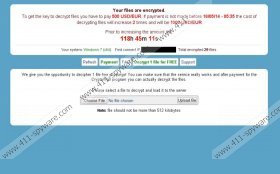Cryptowall Virus Removal Guide
The Cryptowall Virus refers to a malicious program which encrypts various files on the infected computer using the encryption system called RSA-2048. The Cryptowall Virus can get onto your computer in multiple ways, including spam emails and corrupt links, which you may stumble across when browsing websites for adults or some other ad-supported websites.
The Cryptowall Virus creates three files in the location of the encrypted files. These files are called DECRYPT_INSTRUCTION.TXT, DECRYPT_INSTRUCTION.HTML, DECRYPT_INSTRUCTION. The first file contains information regarding the encryption and decryption of the files. The last file takes the user to kpai7ycr7jxqkilp.torexplorer.com/. It is important to note that the URL ends with a randomly generated combination of letters and digits which varies on different computers. Upon double-clicking the third file, the user is informed that his/her files have been encrypted and that a sum of 500 US dollars has to be paid within a particular period of time; otherwise, the sum will increase two times.
You may find that the Cryptowall Virus is also referred to as a ransomware infection. It is so because of the so-called warning, according to which, you have to purchase 1.19 Bitcoins and send them to a particular Bitcoin account. Bitcoins are an electronic currency generated by using the computer power to solve complex algorithm, which is time-consuming. If you have never backed up your data, the payment of the ransom fee may be the only way to get access to your computer. Unfortunately, you cannot be sure that you will regain access to your data after you have paid the money.
There is no need to worry about the removal of the Cryptowall Virus from the computer because it is automatically deleted once the encryption processes is over. In order to decrypt the data, a specific ‘private key’ is necessary. There are some encryption malware programs that do not hide the information relevant to decryption, which enables computer users to restore their file; however, in the present case, the public and private encryption keys are stored on the attacker’s servers.
It is crucial to keep the computer protected against malware and spyware. It is also highly advisable to ignore spam emails and avoid visiting unreliable website, including freeware sharing websites. The more attention to you pay to your online security, the less likely the system will get infected in the future. If you have the Cryptowall virus on your computer and also have a back-up of your data, you should retrieve your data to the computer and provide the computer with protected against malware and spyware.
You can try using the following instructions to decrypt your files, and if you experience any difficulty solving the issue, leave a comment below.
- Open the Start menu.
- Click Control Panel.
- Select User Accounts and Family Safety.
- Select User Accounts.
- Click Manage your file encryption certificates on the left side.
- Click Next.
- Select Use this certificate and click on the certificate detected.
- Click Select Certificate and click Next.
- Click Backup the certificate and key later and click Next.
- Select All logical drives and click Next.
Cryptowall Virus Screenshots:




Comments
I did all the step said above, but when I finished the last step, the computer saids updating encrypted files, but then it stays there, so I am not sure what to do now. thanks.
The steps given in this page is very helpful to understand the cryptowall virus, and the removal details. Thanks for sharing the steps to the readers.